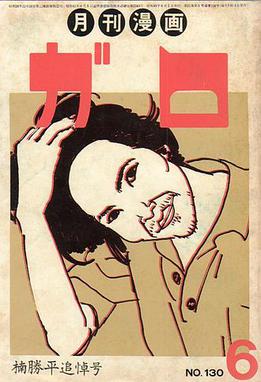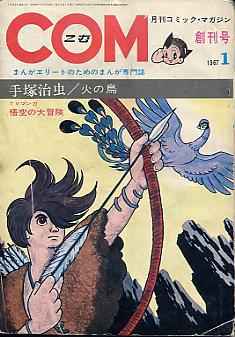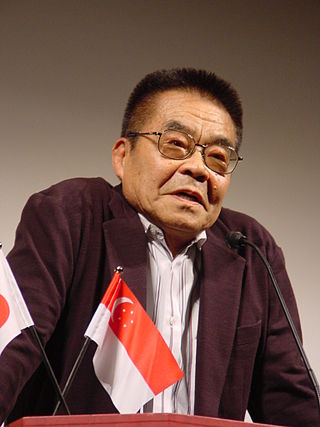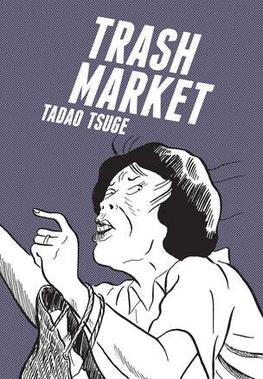
Manga are comics or graphic novels originating from Japan. Most manga conform to a style developed in Japan in the late 19th century, and the form has a long history in earlier Japanese art. The term manga is used in Japan to refer to both comics and cartooning. Outside of Japan, the word is typically used to refer to comics originally published in the country.
Shōnen manga is an editorial category of Japanese comics targeting an audience of adolescent boys. It is, along with shōjo manga, seinen manga, and josei manga, one of the primary editorial categories of manga. Shōnen manga is traditionally published in dedicated manga magazines that exclusively target the shōnen demographic group.

Osamu Tezuka was a Japanese manga artist, cartoonist, and animator. Born in Osaka Prefecture, his prolific output, pioneering techniques, and innovative redefinitions of genres earned him such titles as "the Father of Manga", "the Godfather of Manga" and "the God of Manga". Additionally, he is often considered the Japanese equivalent to Walt Disney, who served as a major inspiration during Tezuka's formative years. Though this phrase praises the quality of his early manga works for children and animations, it also blurs the significant influence of his later, more literary, gekiga works.
Gekiga (劇画), literally "dramatic pictures", is a style of Japanese comics aimed at adult audiences and marked by a more cinematic art style and more mature themes. Gekiga was the predominant style of adult comics in Japan in the 1960s and 1970s. It is aesthetically defined by sharp angles, dark hatching, and gritty lines, and thematically by realism, social engagement, maturity, and masculinity.

Garo (ガロ) was a monthly manga anthology magazine in Japan, founded by Katsuichi Nagai and published by Seirindō from 1964 until 2002. It was fundamental for the emergence and development of alternative and avant-garde manga.

COM was a monthly manga magazine started in December 1966 by Osamu Tezuka and published by his company Mushi Production. It was started in response to the success of Garo, and as a way for Tezuka and other artists to showcase more avant-garde and experimental works in manga. Seven arcs of Tezuka's famous series Phoenix were published in the magazine. COM was particularly influential in amateur manga circles and was a platform for many aspiring manga artists to publish their first professional work. The magazine eventually went bankrupt and its last issue was published in December 1971.

Yoshihiro Tatsumi was a Japanese manga artist whose work was first published in his teens, and continued through the rest of his life. He is widely credited with starting the gekiga style of alternative manga in Japan, having allegedly coined the term in 1957. His work frequently illustrated the darker elements of life.

Manga, in the sense of narrative multi-panel cartoons made in Japan, originated from Euro-American-style cartoons featured in late 19th-century Japanese publications. The form of manga as speech-balloon-based comics more specifically originated from translations of American comic strips in the 1920s, with several early such manga read left-to-right and the longest-running pre-1945 manga being the Japanese translation of the American comic strip Bringing Up Father. The word manga first came into usage in the late 18th century, though it only came to refer to various forms of cartooning in the 1890s and did not become a common word until around 1920.

Yoshiharu Tsuge is a Japanese cartoonist and essayist. He was active in comics between 1955 and 1987. His works range from tales of ordinary life to dream-like surrealism, and often show his interest in traveling about Japan. He has garnered the most attention from the surrealistic works he had published in the late 1960s in the avant-garde magazine Garo.

Trash Market is a volume of semi-autobiographical gekiga short stories by Japanese manga artist Tadao Tsuge. The stories were serialized mainly in the Japanese alternative manga magazine Garo from 1968 to 1972. They were published by Drawn & Quarterly in English on May 12, 2015. Many of the stories are based on Tsuge's life experiences, such as his time at a blood bank, and critics have noted the realism of the stories.

Abandon the Old in Tokyo is a collection of gekiga short stories by manga artist Yoshihiro Tatsumi. It collects eight stories by Tatsumi from 1970, which were serialized in various manga magazines including Weekly Shōnen Magazine and Garo, and was published by Drawn & Quarterly on August 1, 2006. The manga won the 2007 Harvey Award for Best U.S. Edition of Foreign Material, sharing it with the first volume of Tove Jansson's Moomin. It was also nominated for the 2007 Eisner Award for Best Archival Collection/Project – Comic Books.

The Push Man and Other Stories is a collection of gekiga short stories by manga artist Yoshihiro Tatsumi. It collects sixteen stories by Tatsumi which were serialized in the manga magazine Gekiga Young as well as in self-published dōjinshi magazines in 1969. Drawn & Quarterly collected the stories and published them on September 1, 2005. In 2006, the manga was nominated for the Ignatz Award for Outstanding Anthology or Collection and the Harvey Award for Best American Edition of Foreign Material.

Black Blizzard is a Japanese manga written and illustrated by Yoshihiro Tatsumi and published by Hinomaru Bunko in November 1956. It is about two convicts who are handcuffed together and escape after the train they are being escorted on crashes. Written by Tatsumi in twenty days, it is considered to be one of the first full-length gekiga works.

Screw Style is a one-shot gekiga written and illustrated by essayist and mangaka Yoshiharu Tsuge. Screw Style follows of the story of an unnamed boy who goes around several places in war-torn Japan in order to find a doctor who can fix his pierced artery.
Kazuichi Hanawa is a Japanese manga artist.
Yoshikazu Ebisu is a Japanese manga artist and actor.
Sports manga is a genre of Japanese manga and anime that focuses on stories involving sports and other athletic and competitive pursuits. Though Japanese animated works depicting sports were released as early as the 1920s, sports manga did not emerge as a discrete category until the early 1950s. The genre achieved prominence in the context of the post-war occupation of Japan, and gained significant visibility during and subsequent to the 1964 Summer Olympics in Tokyo. Noted as among the most popular genres of manga and anime, sports manga is credited with introducing new sports to Japan, and popularizing existing sports.
Tadao Tsuge is a Japanese alternative manga artist. He is known to write stories about the kimin and burakumin of Japanese society, as well the men who tried to reintegrate into Japanese society after World War II. Tsuge is one of the first artists to create autobiographical work about growing up in poverty in Tokyo. Some themes explored in his work include post-war trauma, class, poverty, masculinity, sex work, geography, and neighborhood environments. He currently lives in Chiba Prefecture, Japan.

The Man Without Talent is a Japanese manga series written and illustrated by Yoshiharu Tsuge, originally serialized in the manga magazine Comic Baku from 1985 to 1986. The series is an I-novel focused on the exploits of an impoverished former manga artist who attempts to support his family through a variety of odd jobs and failed schemes. The Man Without Talent was the final major work published by Tsuge prior to his retirement from manga.
Masahiko Matsumoto was a Japanese manga artist. He is considered a pioneer of alternative manga through his incorporation of cinematic techniques into manga from the mid-1950s onward. His style known as komaga, together with the manga of Yoshihiro Tatsumi and Takao Saito, was the catalyst of the gekiga movement.












